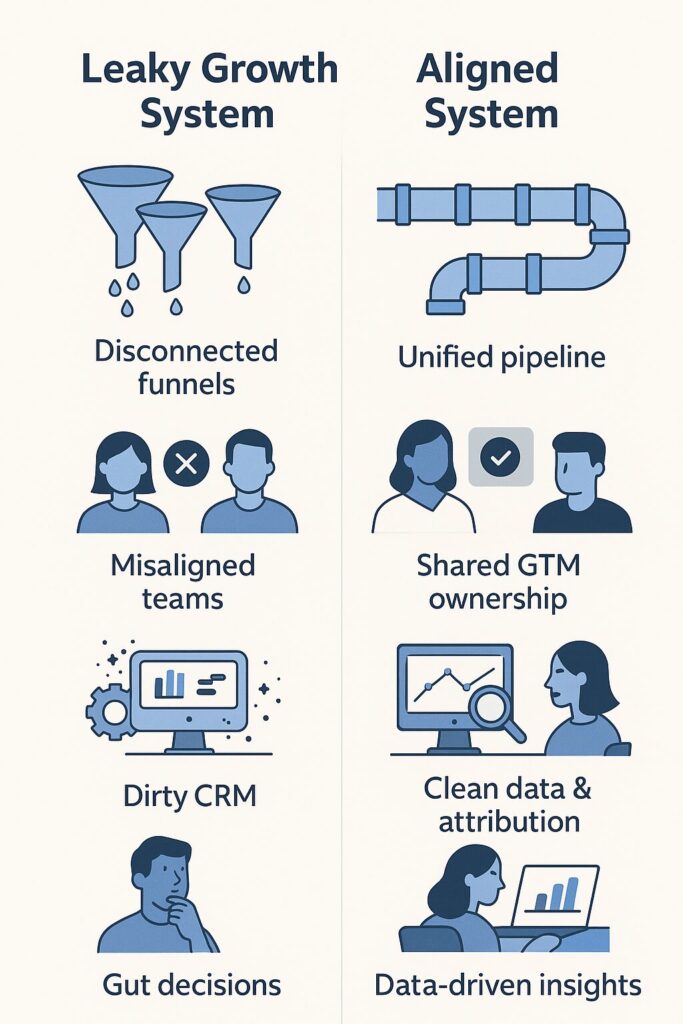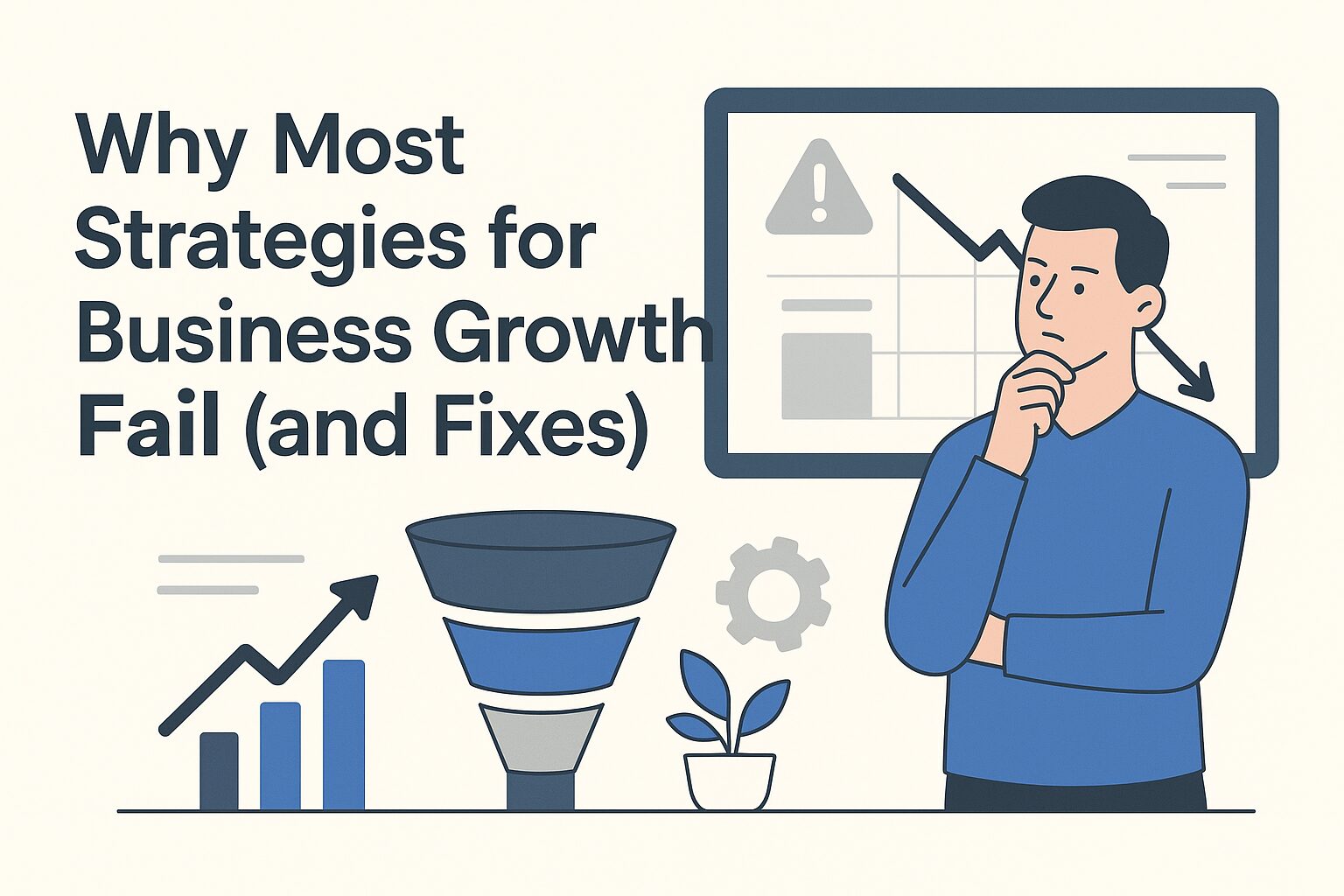What’s Holding Back Your Business Growth?
You’ve experimented with new ad channels, optimized your CTAs tirelessly, and even rebranded multiple times in a short span. Yet, the uphill battle for growth persists, leaving you feeling like you’re pushing a boulder uphill in flip-flops.
Here’s what nobody wants to admit: most companies aren’t failing because they lack creativity or marketing budget. They’re failing because they’re treating growth like a marketing problem when it’s a systems problem.
Real growth isn’t found in the latest campaign hack or shiny new tool; it’s built through operational discipline. However, this growth potential is often obscured by layers of disconnected processes, siloed teams, and data that is as clean as a gas station bathroom.
I learned this the hard way during my consulting years, watching company after company throw money at the same old playbook while their actual growth engines sputtered in the background.
What Most Companies Misunderstand About Growth
Let me paint you a picture. It’s 2021, and I’m sitting across from a SaaS founder insisting his growth problem is all about marketing. Sound familiar?
“We need better ads,” he tells me, pulling up a dashboard that looks like someone threw data at a wall. “Our CPCs are through the roof, and our conversion rates are trash.”
But here’s what was happening: Marketing was generating leads with one message, sales was pitching with a completely different value prop, and the product team had no clue what either group was promising. It was like watching three people try to play the same song on different instruments, in various keys, with their eyes closed.
That disconnect between teams is the classic marketing vs. operations failure, and it kills more growth strategies than any bad ad ever could.

The real growth killers aren’t your ad copy or landing page color. They’re:
- Siloed teams create a Frankenstein customer experience
- Data chaos that forces you to make decisions with your gut instead of your brain
- Fast execution without feedback loops (aka throwing stuff at the wall really, really hard)
When your growth systems aren’t aligned, it doesn’t matter how brilliant your marketing is. You’re essentially trying to fill a bucket with holes in it.
The Hidden Growth Lever: Systems, Not Just Spend
Here’s a metaphor that’ll stick with you: You don’t fix a leaky pipe by turning up the water pressure. You find the leak and patch it.
Most businesses are increasing their marketing spend (like water pressure) when they should be addressing their operational leaks first. Research from McKinsey shows that companies with strong cross-functional alignment grow revenue 19% faster than those with siloed operations.
Growth is an output of well-aligned systems. Period.
The companies that crack the code on scalable growth strategies understand that sustainable growth happens when:
- Your data tells a coherent story across every touchpoint
- Teams have clear, cross-functional ownership of growth metrics
- You’ve built fast feedback loops in business between sales, product, and marketing
- Your operational infrastructure can support the growth you’re trying to generate
Think of it like this: Marketing might be the engine, but operations is the transmission. Without a smooth transmission, all that horsepower just turns into noise and heat.
Case Study: The SaaS Company That Grew by Fixing Its System, Not Its Ads
Let me tell you about that founder I mentioned earlier. His company, a SaaS startup in the competitive CRM space, was burning through $50K/month in ad spend with a customer acquisition cost that made venture capitalists cry. They were struggling to differentiate themselves, and their growth was stagnating.
They’d tried everything in the marketing playbook:
- Hired a fancy new agency (twice)
- Launched a complete brand refresh
- Invested in sales training and new CRM tools
- Even brought in a conversion rate optimization consultant
Six months and $200K later? Growth was still flatlining.
The breakthrough didn’t come from a new campaign or creative. It came from achieving operational alignment, where all teams were working towards the same goals and using the same data and insights to inform their strategies.
Here’s what we fixed:
Customer Clarity Overhaul: We re-mapped their ideal customer profile and discovered marketing was targeting startups while sales was closing mid-market companies. We then aligned our messaging and value propositions to resonate with both these segments, ensuring a consistent customer experience.
Connected the Dots: We integrated product usage data with their retargeting campaigns. Suddenly, marketing could see which leads became power users and optimize for tangible business outcomes, not just vanity metrics.
CRM Hygiene Revolution: Their sales data was so disorganized that attribution was essentially fiction. We cleaned house and built proper tracking so they could finally see which strategies for business growth were working.
The result? Within four months, their CAC dropped 40% and revenue growth accelerated by 60%. The same ad spend and team yielded completely different business growth outcomes.
What changed everything wasn’t a flashy campaign. It was applying sound systems thinking to their growth strategy.
The Growth System Blueprint: Your Five-Pillar Framework
After working with dozens of companies stuck in the growth hamster wheel, I’ve developed a repeatable system that works. Think of it as your business growth framework for achieving sustainable and scalable growth.
Pillar 1: Customer Clarity
- Laser-focused Ideal Customer Profile (ICP): Not just demographics, but psychographics and behavioral triggers
- Journey mapping: Understanding every touchpoint from awareness to advocacy
- Voice of customer integration: Regular feedback loops that inform strategy
Pillar 2: Aligned Inputs
- Consistent messaging: Same value props across marketing, sales, and product
- Coordinated targeting: All teams working from the same customer definitions
- Seamless handoffs: Marketing to sales to customer success without dropping the ball
Pillar 3: Operational Infrastructure
- Clean CRM hygiene: Data you can trust and act on
- Integrated analytics: One source of truth for performance metrics
- Intelligent automation: Systems that scale without losing the human touch
Pillar 4: Feedback Loops
- Customer to product: Regular insights flowing from support to product development
- Sales to marketing: Front-line insights informing campaign strategy
- Performance to strategy: Data-driven pivots based on real results
Pillar 5: Testing System
- Prioritized experiments: ICE scoring for growth initiatives
- Clear success metrics: Knowing what winning looks like
- Fast iteration cycles: Learning and adjusting quickly
According to Harvard Business Review research, companies with a systematic approach to growth testing see 15-25% better results than those running random experiments.
Additionally, research shows that enterprises with strong strategic alignment deliver three times the shareholder returns of those with weaker execution, highlighting how operational harmony directly impacts long-term financial growth.
Want to see how your current systems stack up? I’ve created a Growth Systems Diagnostic that’ll give you a clear picture of where you stand.
Quick Wins to Strengthen Your Growth System Today
Ready to stop the growth theatre and start building fundamental, scalable growth strategies? Here are five things you can tackle this week:
Audit Your Funnel for Trust, Not Just Leads
Stop obsessing over conversion rates and start asking: “Where are we losing credibility?” Mystery shopping your customer journey often reveals more growth opportunities than any A/B test.
Install Cross-Functional Growth Rituals
Start a weekly 30-minute sync between marketing, sales, and product. Simple agenda: What’s working? What’s broken? What should we try next? These feedback loops in business are gold for growth.
Simplify Your Metrics Dashboard
If you need seven different dashboards to understand your growth, you don’t understand your growth. Select 3-5 key metrics and make them visible to everyone.
Create a Customer Feedback Loop
Set up a system that shares customer success insights directly with marketing and product teams. Deloitte research found that customer-centric companies were 60% more profitable compared to companies that were not. Your happiest customers often reveal your best growth strategies.
Score Your Current System
Use an ICE-R framework (Impact, Confidence, Ease, Resources) to evaluate your growth initiatives. Focus your energy on high-impact, high-confidence opportunities first.
Remember, cross-functional growth isn’t about getting everyone to agree. It’s about getting everyone to align around what drives business results.
Systemic Thinking = Your Growth Moat
Here’s the thing about strategies for business growth that most people miss: growth isn’t a tactic you deploy, it’s an outcome you engineer.
And outcomes are driven by systems, not campaigns.
The companies that get this right don’t just grow faster, they produce more predictably. They can scale without breaking. They can pivot without losing momentum. They’ve built what I call “antifragile growth” that gets stronger under pressure.
This systematic approach to growth is no longer just nice to have. It’s table stakes for competing in markets where customer acquisition costs are climbing and attention spans are shrinking.
The question isn’t whether you need better growth systems. The question is whether you’ll build them before your competitors do.
Ready to transform your growth approach from random acts of marketing to systematic business acceleration?
👉 Download the free Growth Systems Diagnostic and discover precisely where your growth engine is leaking potential.
👉 Subscribe to Strategic AI Leader below for weekly insights on building operational excellence that drives results.
👉 Connect with me on LinkedIn to join the conversation about systematic growth and operational leadership.
Related Articles
The Best B2B vs B2C Testing Strategies for 2025
The Ultimate B2C Growth Metrics Guide to Explode Your Revenue
B2C Brand Health Metrics Guide: Unlock Growth Now
How to Create a Winning Data-Driven Sales Strategy
Proven B2B Outreach Strategy That Gets Real Results
B2B Metric Frameworks Infographics: Unlock Growth & Profits Now
About the Author
I write about:
- AI + MarTech Automation
- AI Strategy
- COO Ops & Systems
- Growth Strategy (B2B & B2C)
- Infographic
- Leadership & Team Building
- My Case Studies
- Personal Journey
- Revenue Operations (RevOps)
- Sales Strategy
- SEO & Digital Marketing
- Strategic Thinking
📩 Want 1:1 strategic support?
🔗 Connect with me on LinkedIn
📬 Read my playbooks on Substack

Leave a Reply